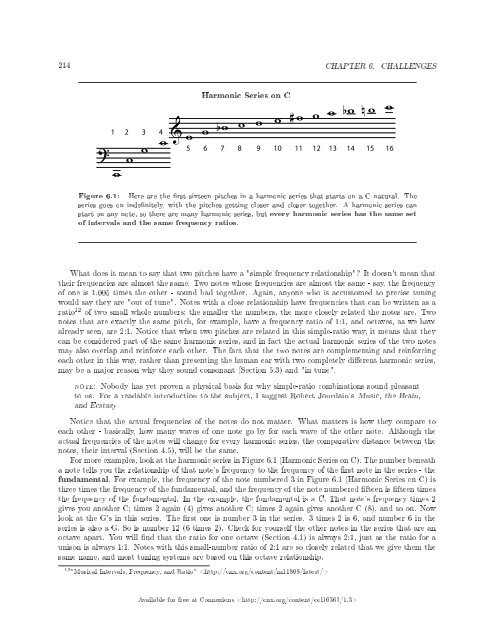Understanding Basic Music Theory, 2013a
Understanding Basic Music Theory, 2013a
Understanding Basic Music Theory, 2013a
Create successful ePaper yourself
Turn your PDF publications into a flip-book with our unique Google optimized e-Paper software.
214 CHAPTER 6. CHALLENGES<br />
Harmonic Series on C<br />
Figure 6.1: Here are the rst sixteen pitches in a harmonic series that starts on a C natural. The<br />
series goes on indenitely, with the pitches getting closer and closer together. A harmonic series can<br />
start on any note, so there are many harmonic series, but every harmonic series has the same set<br />
of intervals and the same frequency ratios.<br />
What does it mean to say that two pitches have a "simple frequency relationship"? It doesn't mean that<br />
their frequencies are almost the same. Two notes whose frequencies are almost the same - say,the frequency<br />
of one is 1.005 times the other - sound bad together. Again,anyone who is accustomed to precise tuning<br />
would say they are "out of tune". Notes with a close relationship have frequencies that can be written as a<br />
ratio 12 of two small whole numbers; the smaller the numbers,the more closely related the notes are. Two<br />
notes that are exactly the same pitch,for example,have a frequency ratio of 1:1,and octaves,as we have<br />
already seen,are 2:1. Notice that when two pitches are related in this simple-ratio way,it means that they<br />
can be considered part of the same harmonic series,and in fact the actual harmonic series of the two notes<br />
may also overlap and reinforce each other. The fact that the two notes are complementing and reinforcing<br />
each other in this way,rather than presenting the human ear with two completely dierent harmonic series,<br />
may be a major reason why they sound consonant (Section 5.3) and "in tune".<br />
note: Nobody has yet proven a physical basis for why simple-ratio combinations sound pleasant<br />
to us. For a readable introduction to the subject,I suggest Robert Jourdain's <strong>Music</strong>, the Brain,<br />
and Ecstasy<br />
Notice that the actual frequencies of the notes do not matter. What matters is how they compare to<br />
each other - basically,how many waves of one note go by for each wave of the other note. Although the<br />
actual frequencies of the notes will change for every harmonic series,the comparative distance between the<br />
notes,their interval (Section 4.5),will be the same.<br />
For more examples,look at the harmonic series in Figure 6.1 (Harmonic Series on C). The number beneath<br />
a note tells you the relationship of that note's frequency to the frequency of the rst note in the series - the<br />
fundamental. For example,the frequency of the note numbered 3 in Figure 6.1 (Harmonic Series on C) is<br />
three times the frequency of the fundamental,and the frequency of the note numbered fteen is fteen times<br />
the frequency of the fundamental. In the example,the fundamental is a C. That note's frequency times 2<br />
gives you another C; times 2 again (4) gives another C; times 2 again gives another C (8),and so on. Now<br />
look at the G's in this series. The rst one is number 3 in the series. 3 times 2 is 6,and number 6 in the<br />
series is also a G. So is number 12 (6 times 2). Check for yourself the other notes in the series that are an<br />
octave apart. You will nd that the ratio for one octave (Section 4.1) is always 2:1,just as the ratio for a<br />
unison is always 1:1. Notes with this small-number ratio of 2:1 are so closely related that we give them the<br />
same name,and most tuning systems are based on this octave relationship.<br />
12 "<strong>Music</strong>al Intervals, Frequency, and Ratio" <br />
Available for free at Connexions


















